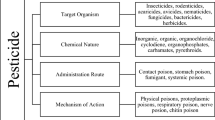Abstract
1,1-Dimethyl-3-(5-tert-butyl-1,3,4-thiadiazol-2-yl)urea(I) was newly synthesized by the authors. (I) was found to have the strongest herbicidal activities among the thiadiazolylurea derivatives and selectivity of (I) was found between barley (tolerant) and wheat (susceptible) plants. Neither absorption by roots nor translocation from roots to shoots of35S-labeled (I) in barley and wheat correlated with selectivity between these species of plants. (I) was metabolized in both species of plants byN-demethylation to 1-methyl-3-(5-tert-butyl-1,3,4-thiadiazol-2-yl)urea(II), and further to non-phytotoxic 3-(5-tert-butyl-1,3,4-thiadiazol-2-yl)urea(III).
The rates of theN-demethylating reactions from (I) to (II) and from (II) to (III) were much greater in barley shoots than in wheat shoots, especially in the second demethylation.
It was concluded that the selective activity of (I) between barley and wheat plants was mainly due to the difference in rates ofN-demethylation of (I). In addition, it was found that cotton plants, well known as tolerant to phenylurea herbicides, were remarkably susceptible to (I). It was indicated that different rates of theN-demethylating reaction between the phenyl and thiadiazolyl herbicides correlated with susceptibility to them.
Similar content being viewed by others
References
Farbenfarbriken Bayer Aktiengesellschaft, Netherland Patent 6813438(1969).
Frear, D. S.: MicrosomalN-demethylation, by a cotton leaf oxidase system, of 3-(4-chlorophenyl)-1,1-dimethylurea (Monuron). Sci.,162, 674 (1968).
Ishizuka, K., I. N. Lee, T. Tatsuno, and Y. Kubota: Mechanisms of activation and inactivation of physiologically active substances in plants (part 13). “On herbicidal activities of 1,3,4-thiadiazolylurea derivatives.” Agr. Biol. Chem.,35, 964 (1971).
Kubo, H., R. Sato, and T. Ohi: Herbicidal activity of 1,3,4-thiadiazole derivatives. J. Agr. Food Chem.,18, 60 (1970).
Kubo, H.: Herbicidal activity of 1,3,4-thiadiazole derivatives. Chemical Regulation of Plants (Japan),4, 146 (1969).
Swanson, C. R., and H. R. Swanson: Metabolic fate of Monuron and Diuron in isolated leaf discs. Weed Sci.,16, 137 (1968).
Smith, J. W., and T. J. Sheets: Uptake, distribution, and metabolism of Monuron and Diuron by several plants. J. Agr. Food Chem.,15, 577 (1967).
Author information
Authors and Affiliations
Rights and permissions
About this article
Cite this article
Lee, I.N., Ishizuka, K. A mode of selective action of thiadiazolyl urea herbicides. Arch. Environ. Contam. Toxicol. 4, 155–165 (1976). https://doi.org/10.1007/BF02221020
Received:
Accepted:
Issue Date:
DOI: https://doi.org/10.1007/BF02221020




